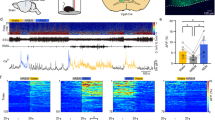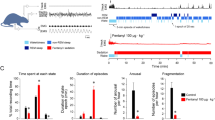Abstract
We investigated the role of regionally discrete GABA (γ-aminobutyric acid) receptors in the sedative response to pharmacological agents that act on GABAA receptors (muscimol, propofol and pentobarbital; 'GABAergic agents') and to ketamine, a general anesthetic that does not affect GABAA receptors. Behavioral studies in rats showed that the sedative response to centrally administered GABAergic agents was attenuated by the GABAA receptor antagonist gabazine (systemically administered). The sedative response to ketamine, by contrast, was unaffected by gabazine. Using c-Fos as a marker of neuronal activation, we identified a possible role for the tuberomammillary nucleus (TMN): when gabazine was microinjected directly into the TMN, it attenuated the sedative response to GABAergic agents. Furthermore, the GABAA receptor agonist muscimol produced a dose-dependent sedation when it was administered into the TMN. We conclude that the TMN is a discrete neural locus that has a key role in the sedative response to GABAergic anesthetics.
This is a preview of subscription content, access via your institution
Access options
Subscribe to this journal
Receive 12 print issues and online access
$209.00 per year
only $17.42 per issue
Buy this article
- Purchase on Springer Link
- Instant access to full article PDF
Prices may be subject to local taxes which are calculated during checkout




Similar content being viewed by others
References
Sawamura, S. et al. Antinociceptive action of nitrous oxide is mediated by stimulation of noradrenergic neurons in the brainstem and activation of α2B adrenoceptors. J. Neurosci. 20, 9242–9251 (2000).
Lin, L.H., Whiting, P. & Harris, R.A. Molecular determinants of general anesthetic action: role of GABAA receptor structure. J. Neurochem. 60, 1548–1553 (1993).
Tanelian, D.L., Kosek, P., Mody, I. & MacIver, M.B. The role of the GABAA receptor/chloride channel complex in anesthesia. Anesthesiology 78, 757–776 (1993).
Franks, N.P. & Lieb, W.R. Molecular and cellular mechanisms of general anaesthesia. Nature 367, 607–614 (1994).
Belelli, I., Pistis, I., Peters, J.A. & Lambert, J.J. General anaesthetic action at transmitter-gated inhibitory amino acid receptors. Trends Pharmacol. Sci. 20, 496–502 (1999).
Krasowski, M.D. & Harrison, N.L. General anesthetic actions on ligand-gated ion channels. Cell Mol. Life Sci. 55, 1278–1303 (1999).
Collingridge, G.L., Gage, P.W. & Robertson, B. Inhibitory post-synaptic currents in rat hippocampal CA1 neurones. J. Physiol. (Lond.) 356, 551–564 (1984).
Gage, P.W. & McKinnon, D. Effects of pentobarbitone on acetylcholine-activated channels in mammalian muscle. Br. J. Pharmacol. 85, 229–235 (1985).
Akaike, N., Tokutomi, N. & Ikemoto, Y. Augmentation of GABA-induced current in frog sensory neurons by pentobarbital. Am. J. Physiol. 258, C452–C460 (1990).
Hales, T.G. & Lambert, J.J. The actions of propofol on inhibitory amino acid receptors of bovine adrenomedullary chromaffin cells and rodent central neurones. Br. J. Pharmacol. 104, 619–628 (1991).
Hara, M., Kai, Y. & Ikemoto, Y. Propofol activates GABAA receptor-chloride ionophore complex in dissociated hippocampal pyramidal neurons of the rat. Anesthesiology 79, 781–788 (1993).
Cheng, S.C. & Brunner, E.A. Inducing anesthesia with a GABA analog, THIP. Anesthesiology 63, 147–151 (1985).
Alkire, M.T. et al. Cerebral metabolism during propofol anesthesia in humans studied with positron emission tomography. Anesthesiology 82, 393–403 (1995).
Fiset, P. et al. Brain mechanisms of propofol-induced loss of consciousness in humans: a positron emission tomographic study. J. Neurosci. 19, 5506–5513 (1999).
Devor, M. & Zalkind, V. Reversible analgesia, atonia, and loss of consciousness on bilateral intracerebral microinjection of pentobarbital. Pain 94, 101–112 (2001).
Sherin, J.E., Shiromani, P.J., McCarley, R.W. & Saper, C.B. Activation of ventrolateral preoptic neurons during sleep. Science 271, 216–219 (1996).
Sherin, J.E., Elmquist, J.K., Torrealba, F. & Saper, C.B. Innervation of histaminergic tuberomammillary neurons by GABAergic and galaninergic neurons in the ventrolateral preoptic nucleus of the rat. J. Neurosci. 18, 4705–4721 (1998).
Lin, J.S., Sakai, K. & Jouvet, M. Evidence for histaminergic arousal mechanisms in the hypothalamus of cat. Neuropharmacology 27, 111–122 (1988).
Lin, J.S., Hou, Y., Sakai, K. & Jouvet, M. Histaminergic descending inputs to the mesopontine tegmentum and their role in the control of cortical activation and wakefulness in the cat. J. Neurosci. 16, 1523–1537 (1996).
Steininger, T.L., Alam, M.N., Gong, H., Szymusiak, R. & McGinty, D. Sleep-waking discharge of neurons in the posterior lateral hypothalamus of the albino rat. Brain Res. 840, 138–147 (1999).
Monti, J.M. Involvement of histamine in the control of the waking state. Life Sci. 53, 1331–1338 (1993).
Pompeiano, M., Cirelli, C., Arrighi, P. & Tononi, G. c-Fos expression during wakefulness and sleep. Neurophysiol. Clin. 25, 329–341 (1995).
Ericson, H., Kohler, C. & Blomqvist, A. GABA-like immunoreactivity in the tuberomammillary nucleus: an electron microscopic study in the rat. J. Comp. Neurol. 305, 462–469 (1991).
Nitz, D. & Siegel, J.M. GABA release in posterior hypothalamus across sleep-wake cycle. Am. J. Physiol. 271, R1707–R1712 (1996).
Steininger, T.L., Gong, H., McGinty, D. & Szymusiak, R. Subregional organization of preoptic area/anterior hypothalamic projections to arousal-related monoaminergic cell groups. J. Comp. Neurol. 429, 638–653 (2001).
Anis, N.A., Berry, S.C., Burton, N.R. & Lodge, D. The dissociative anaesthetics, ketamine and phencyclidine, selectively reduce excitation of central mammalian neurones by N-methyl-aspartate. Br. J. Pharmacol. 79, 565–575 (1983).
Jevtovic-Todorovic, V. et al. Nitrous oxide (laughing gas) is an NMDA antagonist, neuroprotectant and neurotoxin. Nat. Med. 4, 460–463 (1998).
Franks, N.P., Dickinson, R., de Sousa, S.L., Hall, A.C. & Lieb, W.R. How does xenon produce anesthesia? Nature 396, 324 (1998).
Lam, D.W. & Reynolds, J.N. Modulatory and direct effects of propofol on recombinant GABAA receptors expressed in xenopus oocytes: influence of alpha- and gamma2-subunits. Brain Res. 784, 179–187 (1998).
Stell, B.M. & Mody, I. Receptors with different affinities mediate phasic and tonic GABAA conductances in hippocampal neurons. J. Neurosci. 22, RC223 (2002).
Barker, J.L. & Gainer, H. Pentobarbital: selective depression of excitatory postsynaptic potentials. Science 182, 720–722 (1973).
Hoffman, G.E., Smith, M.S. & Verbalis, J.G. c-Fos and related immediate early gene products as markers of activity in neuroendocrine systems. Front. Neuroendocrinol. 14, 173–213 (1993).
Cirelli, C., Pompeiano, M. & Tononi, G. Fos-like immunoreactivity in the rat brain in spontaneous wakefulness and sleep. Arch. Ital. Biol. 131, 327–330 (1993).
Cirelli, C. & Tononi, G. On the functional significance of c-fos induction during the sleep-waking cycle. Sleep 23, 453–469 (2000).
Chou, T.C. et al. Afferents to the ventrolateral preoptic nucleus. J. Neurosci. 22, 997–990 (2002).
Airaksinen, M.S., Alanen, S., Szabat, E., Visser, T.J. & Panula, P. Multiple neurotransmitters in the tuberomammillary nucleus: comparison of rat, mouse, and guinea pig. J. Comp. Neurol. 323, 103–116 (1992).
Gallopin, T. et al. Identification of sleep-promoting neurons in vitro. Nature 404, 992–995 (2000).
Correa-Sales, C., Rabin, B.C. & Maze, M. A hypnotic response to dexmedetomidine, an α2 agonist, is mediated in the locus coeruleus in rats. Anesthesiology 76, 948–952 (1992).
Adodra, S. & Hales, T.G. Potentiation, activation and blockade of GABAA receptors of clonal murine hypothalamic GT1-7 neurones by propofol. Br. J. Pharmacol. 115, 953–960 (1995).
Paxinos, G. & Watson, G. The Rat Brain in Stereotaxic Coordinates (Academic, San Diego, 1998).
Waud, D.R. On biological assays involving quantal responses. J. Pharmacol. Exp. Ther. 183, 577–607 (1972).
Elmquist, J.K., Scammell, T.E., Jacobson, C.D. & Saper, C.B. Distribution of Fos-like immunoreactivity in the rat brain following intravenous lipopolysaccharide administration. J. Comp. Neurol. 371, 85–103 (1996).
Depczynski, B. et al. Distribution and characterization of the cell types expressing GALR2 mRNA in brain and pituitary gland. Ann. NY Acad. Sci. 863, 120–128 (1998).
Villar, M.J. et al. Neuropeptide gene expression in hypothalamic magnocellular neurons of normal and hypophysectomized rats: a combined immunohistochemical and in situ hybridization study. Neuroscience 36, 181–199 (1990).
Saper, C.B. Organization of cerebral cortical afferent systems in the rat. II. Hypothalamocortical projections. J. Comp. Neurol. 237, 21–46 (1985).
Acknowledgements
The Medical Research Council (UK; G9817980 and G9100635), the Westminster Medical Trust (UK) and the National Institutes of Health (USA; HL60292 and AG09975) supported this work.
Author information
Authors and Affiliations
Corresponding author
Ethics declarations
Competing interests
The authors declare no competing financial interests.
Rights and permissions
About this article
Cite this article
Nelson, L., Guo, T., Lu, J. et al. The sedative component of anesthesia is mediated by GABAA receptors in an endogenous sleep pathway. Nat Neurosci 5, 979–984 (2002). https://doi.org/10.1038/nn913
Received:
Accepted:
Published:
Issue Date:
DOI: https://doi.org/10.1038/nn913
This article is cited by
-
Neurobiological effects of gallic acid: current perspectives
Chinese Medicine (2023)
-
Bilirubin potentiates etomidate-induced sedation by enhancing GABA-induced currents after bile duct ligation
BMC Pharmacology and Toxicology (2023)
-
Peri-operative multimodal monitoring: a real need or a luxury?
Journal of Clinical Monitoring and Computing (2023)
-
Effects of general anesthesia on behavioral circadian rhythms and clock-gene expression in the suprachiasmatic nucleus in rats
Histochemistry and Cell Biology (2022)
-
HDAC6 is critical for ketamine-induced impairment of dendritic and spine growth in GABAergic projection neurons
Acta Pharmacologica Sinica (2021)



